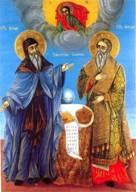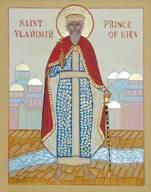Sts. Cyril and Methodius/ Baptism of Russia
ST. CYRIL AND METHODIUS/BAPTISM OF RUS
Objectives:
- Students should know the names Cyril and Methodius and that they told the people of Russia about Jesus.
- Students should know the names of King Vladimir and Queen Olga, the first Christian rulers of Rus.
- Students should know that from Rus, now Ukraine, the gospel spread to the Slavic lands of Russia, Ukraine, and Belarus.
Possible Lesson Plan:
- Open with prayer.
- Tell the story of the Baptism of Rus:
In the city of Thessalonica lived two brothers named Constantine and Methodius. Can you say their names? Practice a few times. They lived about 800 years after the time of Jesus. They had friends who were Greek and friends who were Slavic, from countries to the north who spoke a different language. Methodius became governor of a province in Asia and Constantine went to Constantinople to work for the Patriarch. But, soon both brothers decided to become monks.
Later the king of the Khazars, in southern Slavic lands, sent a messenger to the Emperor asking for someone to be sent who could tell them about the Christian faith. The people were confused by so many different religions. Constantine and Methodius left their monastery and went to Russia. There they taught the king all about the Christian faith. Many people were baptized. Finally, the brothers headed back to Constantinople. They went back to their monastery.
The next year, another messenger came, this time from the land of Moravia. The king there wanted someone to come who could teach the people in their own Slavic language. The empero r immediately thought of Constantine and Methodius, who learned from their friends in childhood. But, how to teach in the Slavic language? There was no alphabet for the sounds, so Constantine had to make up an alphabet to write down the teachings of Jesus. Then, the brothers wrote down the liturgy and parts of the Bible in the new alphabet. When they got to Moravia, they taught the people to read in their own language and started churches with liturgy in their own language. After several years, the brothers went back to the monastery. Constantine was very sick, and was tonsured a monk and given the name of Cyril. So the alphabet he invented is known to this day as the Cyrillic alphabet. Cyril died soon after, and Methodius went back to the Slavic countries as a bishop. He started more churches and trained Slavic priests. The Slavic people were so happy to have their own alphabet and Bible and Liturgy books. Finally, as an old man, Methodius died, still serving Jesus in the Slavic countries.
r immediately thought of Constantine and Methodius, who learned from their friends in childhood. But, how to teach in the Slavic language? There was no alphabet for the sounds, so Constantine had to make up an alphabet to write down the teachings of Jesus. Then, the brothers wrote down the liturgy and parts of the Bible in the new alphabet. When they got to Moravia, they taught the people to read in their own language and started churches with liturgy in their own language. After several years, the brothers went back to the monastery. Constantine was very sick, and was tonsured a monk and given the name of Cyril. So the alphabet he invented is known to this day as the Cyrillic alphabet. Cyril died soon after, and Methodius went back to the Slavic countries as a bishop. He started more churches and trained Slavic priests. The Slavic people were so happy to have their own alphabet and Bible and Liturgy books. Finally, as an old man, Methodius died, still serving Jesus in the Slavic countries.
Even farther north lived a queen named Olga. Olga made a visit to Constantinople and became a Christian and was baptized. But her people were still worshipping gods made of wood. Soon her grandson, Vladimir, became prince. He was not sure what religion was true. So Vladimir sent a group of men to each country to see if its religion was true. The men found beauty and truth in the Christian churches of Constantinople. But, Vladimir was still not sure what was best for his people. Vladimir offered to marry the sister of the Emper ors Basil and Constantine. Her name was Anna. Anna did not want to go to Russia, but hoped that she could help the land of Russia to believe in Jesus. Vladimir, meanwhile, had gone blind; he could not see. He was told that he would not see until he was baptized. Vladimir decided this would be a test to prove the true God and was baptized. He was healed!
ors Basil and Constantine. Her name was Anna. Anna did not want to go to Russia, but hoped that she could help the land of Russia to believe in Jesus. Vladimir, meanwhile, had gone blind; he could not see. He was told that he would not see until he was baptized. Vladimir decided this would be a test to prove the true God and was baptized. He was healed!
Now Vladimir wanted his people to know the true faith also. He burned their idols of wood – nothing happened. These were false gods with no power. Then he told all the people, rich and poor, young and old, to meet him on the banks of the Dneiper River the next morning. Prince Vladimir told them all about Jesus and their need to be baptized. They waded right into the river -- mothers, fathers, children, babies – all were baptized that day. So Vladimir is remembered as the “Baptizer of Rus”, equal to the apostles. From Rus, now Ukraine, the gospel spread to what is today Russia, Belarus, and Ukraine.
Add Sts. Cyril and Methodius and Sts Vladimir and Olga to your timeline.
- Feed the Elephant True/False Questions:
True False
Cyril made a new alphabet for the Slavs. Cyril made the Slavs learn Greek.
Cyril and Methodius were brothers. Cyril and Methodius were father and son.
Queen Olga of Rus became a Christian. Queen Olga of Rus worshipped idols.
Prince Vladimir baptized Rus. Queen Olga baptized Rus.
- Work on the difficult names of these important saints: Cyril (originally Constantine), Methodius, Vladimir, and Olga. Does any student or their relative have one of these names; what about Walter, the English name for Vladimir? Which ones were missionaries/evangelists? Which were rulers? Which were monks?
- Make 2 stand-up puppets, a king and a queen. Cut the bodies out of white cardstock and decorate with gold glitter glue crowns, color faces, yarn for hair or beard if desired. Cut robes from colored construction paper. Glue body inside center section of robe. Fold robe sides forward.
- Close with prayer: Lord, help me to love people who are different from me and speak other languages and to tell them about Jesus and bring them to Church to hear about You.
S